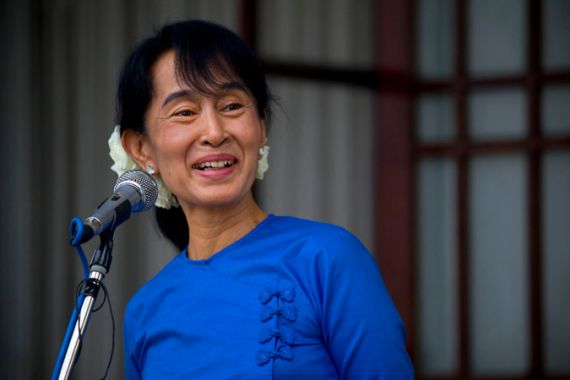The lynchpin of Asia
Realpolitik, economic interests, ideals and the quest for freedom will shape the great game playing out in Myanmar.

New Delhi, India – Isolated and impoverished by decades of international sanctions, Myanmar has emerged in recent months as both a beacon of hope and a potential new Asian flashpoint. With Nobel laureate Aung San Suu Kyi freed from two decades of house arrest to campaign vigorously for a seat in parliament in the special election to be held on April 1, Myanmar’s commitment to rejoining the international community appears to be genuine. But this opening has other consequences, most importantly setting the stage for a new “great game” of strategic competition.
No one should be surprised that Myanmar is a locus of interest for great powers. After all, it is larger than France and with a similar population size. In his recent book, Monsoon, Robert Kaplan notes that, in the Middle Ages, three kingdoms lay between Thailand (then named Siam) and India. One was Myanmar, which means “that which is central”. Centuries later, the country remains central, not only in matters of Asian security, but also for the country’s vast and still mostly untapped natural wealth.
|
|
Myanmar’s strategic importance reflects, first and foremost, its geographic location between India, China, Thailand and Southeast Asia. Ringed in the north by the southern ridges of the Himalayas, to the east by foothills of dense teak forests, and to the west and south by the Bay of Bengal and Indian Ocean, Myanmar’s geography has always shaped the country’s history and politics.
In 1885, during an earlier era of great power competition in Asia, Lord Randolph Churchill, Winston Churchill’s father, impulsively annexed Myanmar to the British Raj in India following the Third Anglo-Burmese War. Thant Myint-U, a leading historian of contemporary Myanmar (and the son of former United Nations Secretary-General U Thant), likened Churchill’s move to “throwing Burma off a cliff”.
Only in 1937, by a decree of the British viceroy, was Myanmar finally separated from British India. But the Japanese invasion five years later subjugated Myanmar and its people to colonial rule once again, with the conquering sweep of the Imperial Japanese Army checked only at Imphal, in India’s Manipur state.
The end of the British Empire in 1947 gave Myanmar its freedom, but did not end its travails. The assassination of Aung San (Suu Kyi’s father and the leader of Myanmar’s independence movement) destabilised the country, paving the way for the army to take over. Under its long-serving military junta, Myanmar shut itself off from the world, internalised its problems and stagnated as the rest of Asia boomed. The world reciprocated, isolating Myanmar economically and diplomatically.
It was to this Myanmar that I journeyed from Imphal some ten years ago, the first Indian foreign minister to travel overland to its neighbour since independence. India’s Border Roads Organisation had recently completed the first all-weather road connecting the two countries since WWII. Journeying on this “road to fabled Mandalay”, I recorded in my diary, was a highlight of “one of the most memorable, satisfying and happy foreign visits in my experience as foreign minister”.
China, too, has endeavoured for centuries to bind Myanmar to itself, mostly in search of a southern route to India and the Indian Ocean. In recent decades, China took advantage of the international community’s shunning of Burma to secure its own strategic interests, building highways, railways, ports and pipelines that connect southern and western China to the Indian Ocean.
But trade has not been China’s only motivation for investing so heavily in Myanmar. China also views Myanmar as vital to its quest for security, as well as to the regional expansion of Chinese power.
Reflecting its fears about the potential for Chinese encirclement, democratic India, after early hiccups of doubt, set aside its scruples about Myanmar’s military regime. India’s cultural, economical, social and sometimes military ties with Myanmar – indeed, with the entire region – are older than China’s. So, for reasons of realpolitik, India has expanded its activities and investments in Myanmar throughout the past two decades of the junta’s rule.
Sometimes the competition with China is direct. At the Shwe gas fields along the Myanmar cost, estimated to be among the largest reserves in the world, two pipelines are to be constructed: one to China from the nearby port of Kyauk Phru and the other to India from the port of Sittwe.
|
|
For Thant, this strategic competition is worrying. The “crossroads through Burma”, he argues, cannot “be a simple joining up of countries”, because the regions of “China and India that are being drawn together over Burma are among the most far-flung parts of the two giant states, regions of unparalleled ethnic and linguistic diversity… isolated upland societies that were, until recently, beyond the control of Delhi or Beijing”.
While China seeks strategic depth in Myanmar, India’s interests there are now reanimated by the international community’s opening to a country that appears to yearn for the same democratic freedoms that Indians possess. And, in Aung San Suu Kyi, who studied in New Delhi (as did her mother, Daw Khin Kyi, who was Ambassador to India and Nepal in 1960), Burma possesses a charismatic moral leader who reminds Indians of their country’s own founders.
As a result, realpolitk and economic interest alone will no longer shape the great game playing out in Myanmar. Ideals and the quest for freedom will also play a critical role.
Jaswant Singh, a former Indian finance minister, foreign minister and defence minister, is the author of Jinnah: India – Partition – Independence.
A version of this article first appeared on Project Syndicate.
